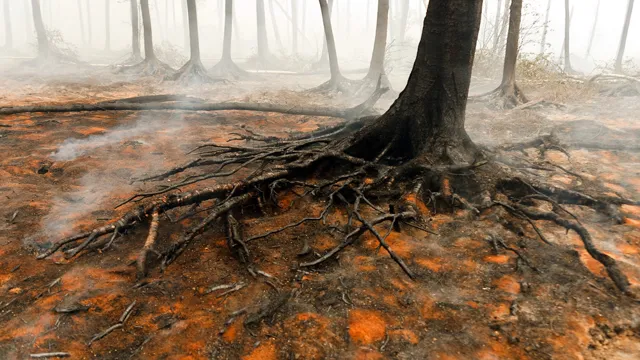What Is a Root Fire and How Does It Impact Forest Ecosystems?

Have you ever seen a forest fire but noticed that the flames weren’t coming from the ground? It might be because you witnessed a root fire, also known as a subsurface fire. Root fires occur when fire burns underground and feeds on organic material in the soil. While not as visible as surface fires, root fires can cause significant damage to ecosystems and even start surface fires.
Understanding the causes and effects of root fires is crucial for managing and preventing these destructive fires. In this blog, we’ll explore the science behind root fires and ways to combat them. So grab a cup of coffee, sit back, and let’s dive into the world of root fires.
Introduction
Imagine a fire burning underground, hidden from sight but slowly smoldering and spreading. That’s essentially what a root fire is – a type of wildfire that burns beneath the surface of the ground, often in areas with thick plant cover. These fires are difficult to detect because they don’t produce much smoke or visible flames, and can therefore burn for long periods of time without being noticed.
However, they can cause significant damage to the roots of plants and trees, as well as the soil structure, making recovery after the fire difficult. Root fires can also be dangerous for firefighters because the ground can collapse unexpectedly, and smoke and heat can reach the surface suddenly and violently. Overall, root fires can be a serious threat to both natural ecosystems and human infrastructure, and require careful monitoring and management to prevent and contain.
Defining Root Fires
Root fires are one of the most dangerous types of fires that can occur in wooded areas. These fires are unique because they occur underground, burning roots and organic matter that slowly spread and can cause problems for months after the actual fires have been extinguished. As the name implies, these fires start at the base of trees, typically without any visible signs on the surface.
They can smolder and spread for long periods, releasing smoke and heat from the underground fires that eventually result in visible flames above ground. Defining root fires is essential for forest management, as they require specialized equipment and techniques to extinguish effectively. Therefore, understanding the occurrence, causes, and impacts of root fires is essential to combat this type of fire in a timely manner.

Causes of Root Fires
Root fires can be incredibly destructive and difficult to control. They occur when the underground roots of trees or plants catch fire, which can spread to nearby vegetation or even structures. There are several potential causes of root fires, including lightning strikes, wildfires, and human activities such as campfires or discarded cigarettes.
In some cases, root fires can also occur naturally due to the buildup of flammable gases in the soil, such as methane or hydrogen sulfide. Regardless of the cause, it is important to take steps to prevent root fires whenever possible, such as ensuring campfires are properly extinguished and avoiding burning yard waste near trees or plants with extensive root systems. By being proactive about preventing root fires, we can help protect our natural ecosystems and prevent unnecessary destruction and loss.
Impact of Root Fires
Have you ever heard of a root fire? It’s a type of wildfire that ignites in the roots of trees and shrubs, rather than the aboveground vegetation. Root fires can be extremely dangerous because they burn hot and deep, making them difficult to extinguish. They can also cause long-term damage to the ecosystem by destroying the underground root systems of plants and trees, which are essential for water and nutrient uptake.
Additionally, root fires can have a significant impact on soil health, leading to erosion and loss of valuable nutrients. These fires are often caused by lightning strikes, but can also be started by human activities such as campfires or discarded cigarettes. To prevent root fires from occurring, it’s important to be cautious when using fire outdoors, and to make sure all fires are completely extinguished before leaving the area.
Ecological Effects
Root fires pose a severe threat to the ecological balance of forests and other critical ecosystems. When a fire ignites and burns underground, it can seriously damage the root system of trees and vegetation. As a result, this can lead to long-term ecological impacts like soil erosion, nutrient depletion, and decreased biodiversity.
The root fires also reduce the natural water-holding capacity of the soil, thereby accelerating the process of desertification. In some cases, the root fires cause the soil to become dry and compact, which makes it difficult for vegetation to re-establish itself. Additionally, root fires release a significant amount of carbon dioxide into the atmosphere, which can contribute to global warming and climate change.
It is imperative to manage and control root fires to prevent their harmful effects and protect our planet’s delicate ecosystems.
Economic Effects
Root fires can have significant economic effects on the surrounding area. The destruction caused by the fire can lead to a loss of natural resources, which can have a direct impact on the local economy. For example, if the root fire destroys a large area of forest, the timber industry in that region can suffer greatly.
Furthermore, root fires can cause long-term damage to the soil, making it difficult for crops to grow in the future. This can affect the agricultural industry and cause a decrease in food production. In addition to the direct economic effects, root fires can also impact local tourism.
Natural landscapes that once attracted tourists may be destroyed in the fire, leading to a decline in tourism and further economic loss. Overall, the economic effects of root fires can have long-lasting consequences on the local economy, potentially taking years to fully recover.
Health Effects of Root Fires
Root fires are incredibly destructive, and their impact can be felt long after the flames have been extinguished. These fires are notorious for their ability to smolder and burn for extended periods, often deep underground. As a result, root fires can have significant effects on the surrounding ecosystem, causing significant harm to the vegetation and wildlife in the area.
Even worse, root fires can also have severe health consequences for the people exposed to the smoke and ash. These tiny particles can cause respiratory problems, aggravate existing conditions such as asthma, and increase the risk of lung cancer. It is therefore necessary to take appropriate measures to reduce the incidence of root fires and minimize their impact on the environment and human health.
Preventing Root Fires
A root fire is a forest fire that spreads underground along the roots of trees and vegetation. These fires can smolder for long periods of time, undetected, without causing any visible flames or smoke on the surface. In order to prevent root fires, it is important to manage the forest floor by removing dead leaves, branches, and other debris that can accumulate and contribute to the spread of underground fires.
Additionally, maintaining a proper balance of vegetation in the area can prevent fires from starting or spreading. Proper management of the forest also includes ensuring that the area is not overgrown, which can lead to an abundance of vegetation that can easily ignite due to hot weather conditions, lightning strikes, or other factors. Prevention efforts may also include creating fire breaks or clearing areas around vulnerable structures to minimize the risk of fire damage.
By taking proactive steps to manage the forest, we can help prevent root fires and minimize the risk of catastrophic forest fires that can have devastating effects on the environment, animal habitats, and human communities.
Best Practices for Prevention
Preventing Root Fires Root fires can be a frustrating and dangerous problem for homeowners, but luckily there are plenty of preventative measures that can be taken. The first step is to make sure that any outdoor fires are started in areas without roots or other flammable materials nearby. This means clearing out any debris or dead wood, as well as being careful when starting fires near trees.
It’s also important to keep a close eye on any fires that are burning, making sure that they don’t spread or get out of control. If you’re using a fire pit or similar device, be sure to keep it covered when not in use and ensure that it’s properly ventilated. Finally, if you notice any signs of a root fire (such as smoke or visible flames coming from the ground), it’s important to call the fire department immediately and evacuate the area until help arrives.
By following these best practices, you can help prevent root fires and keep your property safe.
Technology and Research for Prevention
Preventing Root Fires using Technology and Research Forest fires are a common occurrence, and preventing them is crucial to our environment’s health. Did you know that most forest fires start from the roots? Yes, that’s right! And it’s called a root fire. Root fires happen when the soil underneath the surface is combustible due to the accumulation of dry organic matter.
This issue is common in forests and is particularly common in areas with a hot and dry climate. But thanks to technological advancements and research, we can now prevent root fires. Mapping technology can identify potential risk areas, while moisture monitoring systems can detect the water content in the soil and provide insight into the root fire’s potential fuel.
By understanding how root fires start, we can take preventative measures to protect our forests. One crucial way to prevent root fires is controlling the soil moisture level. Controlling soil moisture can help to reduce the risk of a root fire.
Monitoring systems are being used by experts to track moisture levels. These systems are placed in the soil and provide real-time data, which is used to determine whether the soil is dry enough to create a potential fire hazard. Knowing whether a fire risk exists will allow forest management teams to respond quickly and take immediate preventive measures, such as clearing debris from the ground and removing highly combustible materials.
In conclusion, we must use technology and research to prevent root fires. It is crucial to our environment and the health of our forests. With the increasing temperature and climate change, it is essential to ensure that proactive and preventive measures are taken to reduce the risk of root fires.
Through mapping technology and moisture monitoring systems, we can make a difference in preventing root fires and ensure the safety of our forests.
Conclusion
In short, a root fire is not just any ordinary fire, but rather a fierce and powerful force that ignites deep within the very foundation of a system. It is the spark that sets a chain reaction in motion, the driving force that fuels change and growth. It is the fiery passion beneath the surface that has the power to transform and shape the world around it.
So, if you feel that burning desire within you, don’t be afraid to let it ignite and unleash your own root fire!”
FAQs
What is a root fire?
A root fire is a fire that burns underground in the root systems of trees and plants.
What causes a root fire?
A root fire can be caused by lightning strikes, campfires, cigarettes, or other types of human-caused fires.
How do root fires start?
Root fires can start when a nearby surface fire burns hot enough to ignite the organic material in the soil, which can then smolder and burn the roots.
How do you put out a root fire?
Putting out a root fire can be difficult, as it is underground and can smolder for long periods of time. It may require digging up the affected area and thoroughly extinguishing the fire.
Can root fires cause damage to trees and plants?
Yes, root fires can damage or kill trees and plants by burning their roots and depriving them of oxygen and nutrients.
Are root fires common?
Root fires may not be as common as surface fires, but they can occur in dry or drought-prone areas with high fuel loads.
How can you prevent root fires?
Preventing root fires requires being responsible with fire use and making sure campfires are properly extinguished. It is also important to clear any brush or debris around structures and maintain defensible space around homes.




